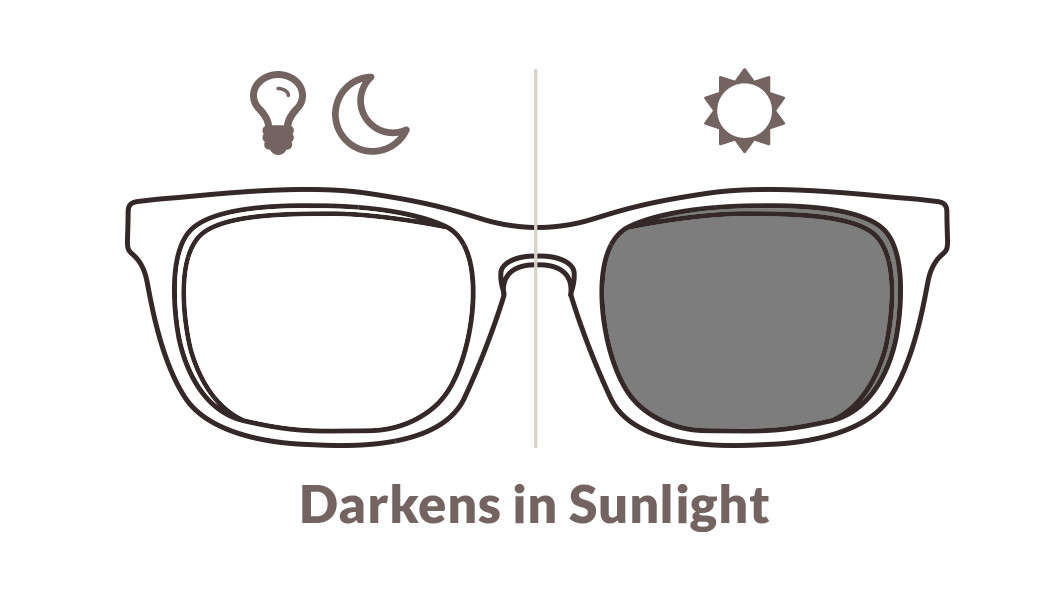Photochromic vs transitions: Which one should you get?
Shopping from Canada? Check out the Zenni Canada site.
This article was revised on July 19, 2023.

What are photochromic lenses?
Photochromic lenses are lenses that are clear indoors and darken in sunlight. They are great value for your money as two-in-one glasses and sunglasses.
What are transition lenses?
Transitions® lenses are the top-performing photochromic lens on the market. They change more quickly than other photochromic lenses and can activate up to a category 3 darkness outdoors.
How much are transition lenses?
You can get a complete pair of Transitions® glasses at Zenni for as low as $77.90, excluding shipping and taxes. Transitions® Signature® Gen8™ lenses range from $70.95 to $168.95 for Single Vision and from $138.95 to $214.95 for progressives. Transitions® XTRActive® Polarized™ lenses range from $121.95 to $214.95 for Single Vision and from $168.95 to $261.95 for progressives.
If you are looking for an even more affordable option, Zenni offers its own line of photochromic lenses, starting at $38.95. Another option is Vision-Ease LifeRx® lenses, starting at $72.95.
What photochromic lenses are available?
- Transitions® Signature® Gen8™: fully clear indoors and quickly darken outdoors. The lenses block 100% UVA and UVB rays and filter harmful blue light.1
- Transitions® XTRActive® Polarized™: clear with a hint of protective tint indoors and darken up to category 3 in sunlight or in the car with polarization to reduce glare. The lenses block 100% UVA and UVB rays and filter harmful blue light.2
- Blokz™ Photochromic: Zenni photochromic lenses darken anywhere from 60%-80% in bright sunlight and protect against potentially harmful blue light.
- Zenni’s standard Photochromic lenses: Zenni photochromic lenses darken anywhere from 60%-80% in bright sunlight.
- Vision-Ease LifeRx®: polycarbonate photochromic lenses darken to around 35-55% in bright sunlight. The impact-resistant material is great for rimless glasses, sports enthusiasts, and children.
Are photochromic lenses available for progressives and bifocals?
- Standard progressives: all photochromic lenses are available.
- Workspace progressives: photochromic lenses are not available.
- Bifocals: 1.57 Zenni photochromic lenses are available.
What lens index is available for photochromic lenses?
- Transitions® Signature® Gen8™ is available in 1.50 Photochromic Transitions® and 1.61 or 1.67 Photochromic High-Index Transitions®.1
- Transitions® XTRActive® Polarized™ is available in 1.50, 1.53 or 1.67 Polarized Transitions®.2
- Blokz™ Photochromic is available in 1.61 or 1.67 Blokz™ Photochromic.
- Zenni’s standard Photochromic lens is available in 1.61 Photochromic High-Index.
- Vision-Ease LifeRx® is available in 1.59 Photochromic Polycarbonate Impact-resistant.
What colors are available for photochromic lenses?
- Transitions® Signature® Gen8™ is available in gray and brown. Sapphire and amethyst are available for selected frames.1
- Transitions® XTRActive® Polarized™ is available in gray.
- Blokz™ Photochromic is available in gray.2
- Zenni’s standard Photochromic lens is available in gray for all prescription types and amber for Single vision.
- Vision-Ease LifeRx® is available in gray and brown.
What’s the difference between polycarbonate photochromic lenses and regular photochromic lenses?
Polycarbonate photochromic lenses are more impact-resistant than regular photochromic lenses. The Vision Ease LifeRx® polycarbonate photochromic lenses are a good choice for rimless glasses and kids.
How long does it take for the photochromic lenses to transition between clear and tinted?
Transitions® Signature® Gen8™ photochromic lenses start to darken within seconds and return to clear indoors up to 3 minutes faster than previous generations.1 Zenni and Vision East LifeRx® photochromic lenses take a couple of minutes to darken and return back to clear.
Sources:
1Transitions® Signature® Gen8™: https://www.transitions.com/en-us/products/transitions-signature/
2Transitions® XTRActive® Polarized™: https://www.transitions.com/en-us/products/transitions-xtractive-polarized/
About the Author: Dr. Mori Ahi, O.D.
Dr. Mori has over 10 years of experience in eye care. She earned her undergraduate degree from UCLA and her optometry degree from the New England College of Optometry. She has worked in a variety of eye care settings and is passionate about helping her patients find a great pair of affordable glasses


 United States
United States